INTRODUCTION TO THE DIADORA GARA CARBON
ROBBE: Diadora was born in Italia, and continues to run the family-owned business at the foot of the Dolomites, home to some of the world’s most iconic designers. It should be no surprise that at their core lies an attention to detail and a commitment to design and innovation at an intentional pace. And while almost every brand uses production facilities in China or southeast Asia for their footwear production, in recent years, Diadora has moved some of its product line back to its Italian factory, using its own Italian craftsmanship from workers who have been with the company for decades. (We’re specifically talking about the Diadora Atomo v7000, one of our favorite convertible running/lifestyle shoes, which is on my feet as I type out this review.)
That said, the Diadora Gara Carbon is not one of those shoes. It is made in China. But so is the Nike Alphafly 3. And Saucony Endorphin Pro 4. And pretty much every other race day shoe. Point being, the “Made in Italy” thing is great from a storytelling aspect, but in 2024, you’re going to get a pretty damn good product wherever it’s made.
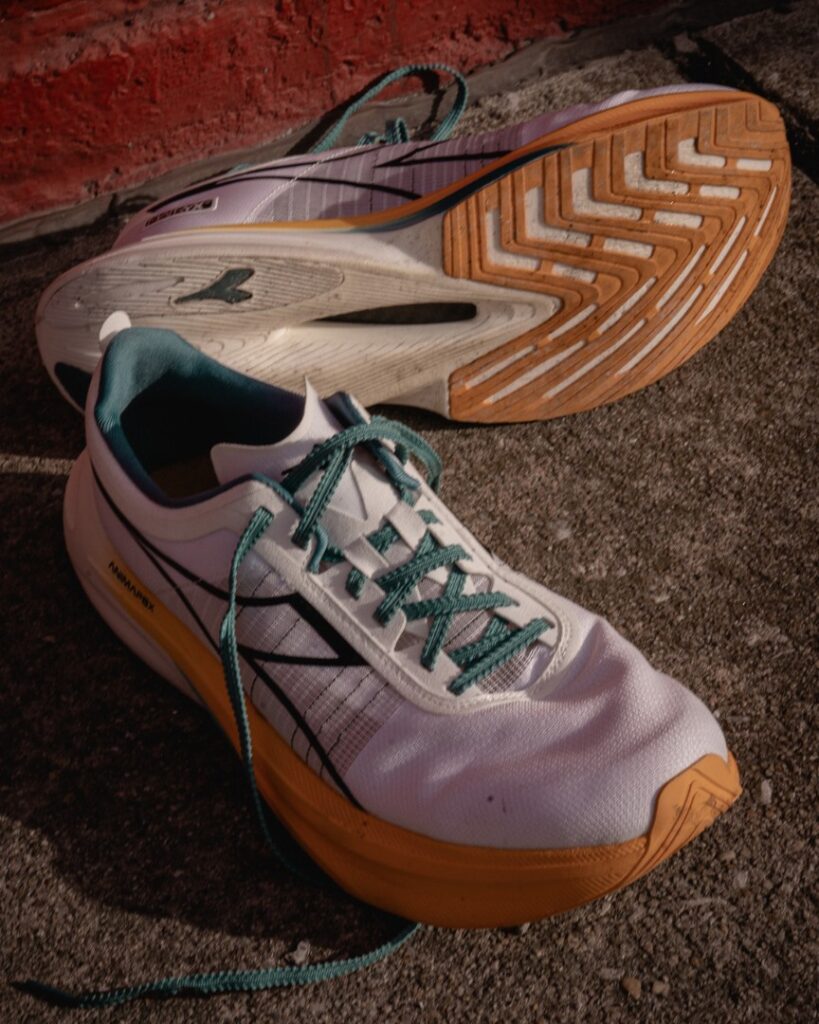
Race-style laces

Matryx upper
Speaking of 2024, at this point in time we’re a good half-decade into the super shoe boom, and just about every brand that has a balance sheet has a carbon-plated race day shoe. Hell, Austin-based Atreyu has about two employees and an office dog as their full-time staff, and even they have a race day shoe (The Race Model).
And yet somehow, despite the fact that they live in the land of Lambos, Diadora has never had a real race day shoe. Which is why we were skeptical about the Gara Carbon when we first saw it at The Running Event this past December. Don’t get me wrong– once we held it hand, we were quite interested.
The shoe is very light, coming in at over an ounce lighter than competitors like the Saucony Endorphin Pro 4. It has a legit Pebax SCF midsole (what they call Anima PBX) and its carbon fiber plate was sourced from the same factory used by Ducati motorcycles. A premium Matryx upper (known for its durability and breathability properties) wraps the foot, while tooth-style race laces finish off the package. Lastly, of course– it looks incredible.
That’s a lot of good things in one race day package. But when it’s thrown into fifth gear, how does it handle? Let’s find out.
CARYN: Before I ever considered running as an activity folks did for fun, I was purely a ball sports athlete. I was pretty quick, but I was only running if some kind of game was involved. If someone had told 13-year old me one day I’d be running 70 miles a week for fun… well, let’s just say there would have been a pretty prolific eye roll. I was also, by definition, a pool rat throughout my summers growing up – dropped off at 8 am and picked up after dinner. Every day was tennis camp and two swim team practices with trips to the snack bar for snowballs, Fun-Dip, and grilled cheese peppered in.
I’d imagine right about now you’re wondering why any of this is relevant to the Diadora Gara Carbon, the shoe we’re all here to chat about today. If you must know, It was during tennis camp that I was first exposed to the immaculate vibes of DIadora. All of the coolest, nicest camp instructors had on Diadora tennis shoes. The vintage, classic look and beautiful color combinations stood out from anywhere on the court. While I never quite reached Borg status (and therefore, never needed the special shoes), I’m thrilled to be able to test a bit of Diadora in the running space with their first plated racing shoe, the Gara Carbon.
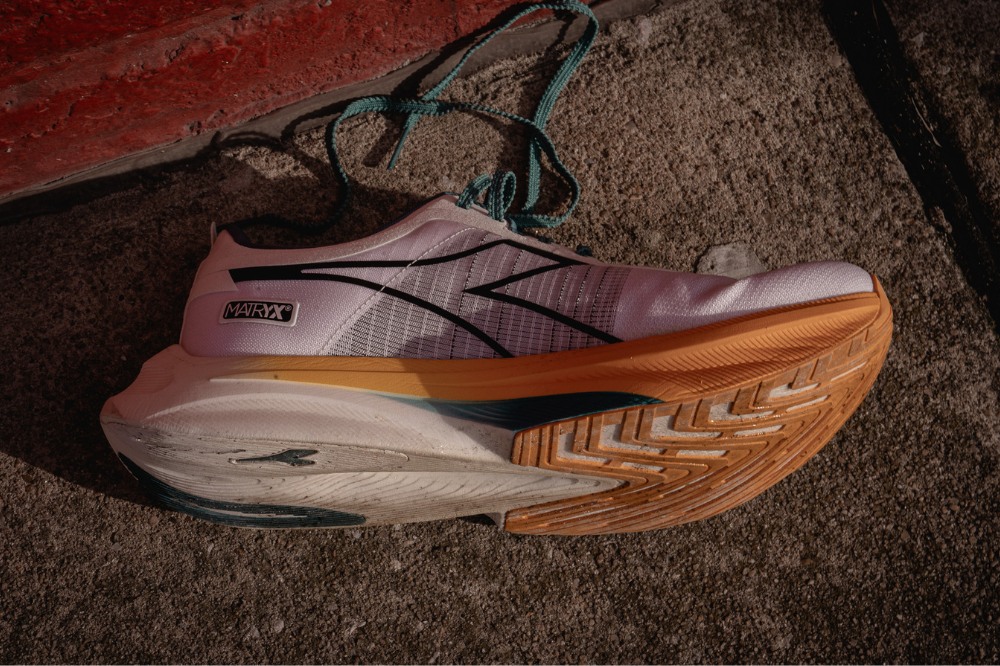
SAM: I’m about to nerd out so please bear with me. Gaara is one of my favorite characters in all of television, let alone the Naruto series. He starts off as a villain during the Chunin exams, a cynical, powerful, yet misunderstood and insecure ninja. After being defeated by Naruto he begins one of the best character transformations I know of. In Naruto Shippuden he is even more powerful and has lost his cynical and insecure nature to embrace his leadership potential and the value of friendship
While the Diadora Gara Carbon is related to Naruto’s character through name only, (Gara roughly translates to race or competition in Italian), the path of Diadora’s running shoes feels similar to the Jinchuriki of the Hidden Village of the Sand. Mainly known in the States for tennis, cycling, or football boots (soccer cleats), Diadora has made a concerted push into the US running shoe market over the last half decade. So far it has felt misunderstood and misrepresented, with good-looking and reliable shoes, but nothing to speak of as far as high performance footwear. I am pleased to say that has changed with the Gara Carbon. Let’s talk about why.
WHAT WE LIKE ABOUT THE DIADORA GARA CARBON
ROBBE: I already told you how good it looks, and everyone else who’s seen it tells us how good it looks. The design is among the best for race day shoes. If you have eyes with adequate vision, you know what we’re talking about. If you’re blind, just trust us on this one.
I think this is the first time I’ve seen a Matryx upper used on a race day shoe, though we’ve seen their premium materials used in a variety of shoes on the trail side, namely the Hoka Tecton X 2, Hoka EVO Speedgoat (R.I.P.), and the Nnormal Kjerag. The difference in Matryx uppers is that they’re super light and ultra breathable. In contrast to fully coated textiles that are typically used in uppers, each yarn in a Matryx upper is coated individually. In this way, your feet breathe and stay dry while perspiration drains away. It’s also highly abrasion resistant without sacrificing comfort. Simply put, this upper will outlast the rest of the shoe, no question about it.
I found all of Matryx qualities to be true with the Gara Carbon. The lockdown and fit is superb, with the upper full wrapping the foot securely. The tongue is not gusseted, but with a dual lace hold in the middle and a perfectly flat lay, I had no issues with movement. Also, unlike some race day shoes, the tongue doesn’t ride up on the front of the ankle. There’s also a surprising amount of padding around the collar, which is rare to find in a lightweight race day shoe. And thank you, Diadora, for just using the standard race day tooth-style laces that we know and love.
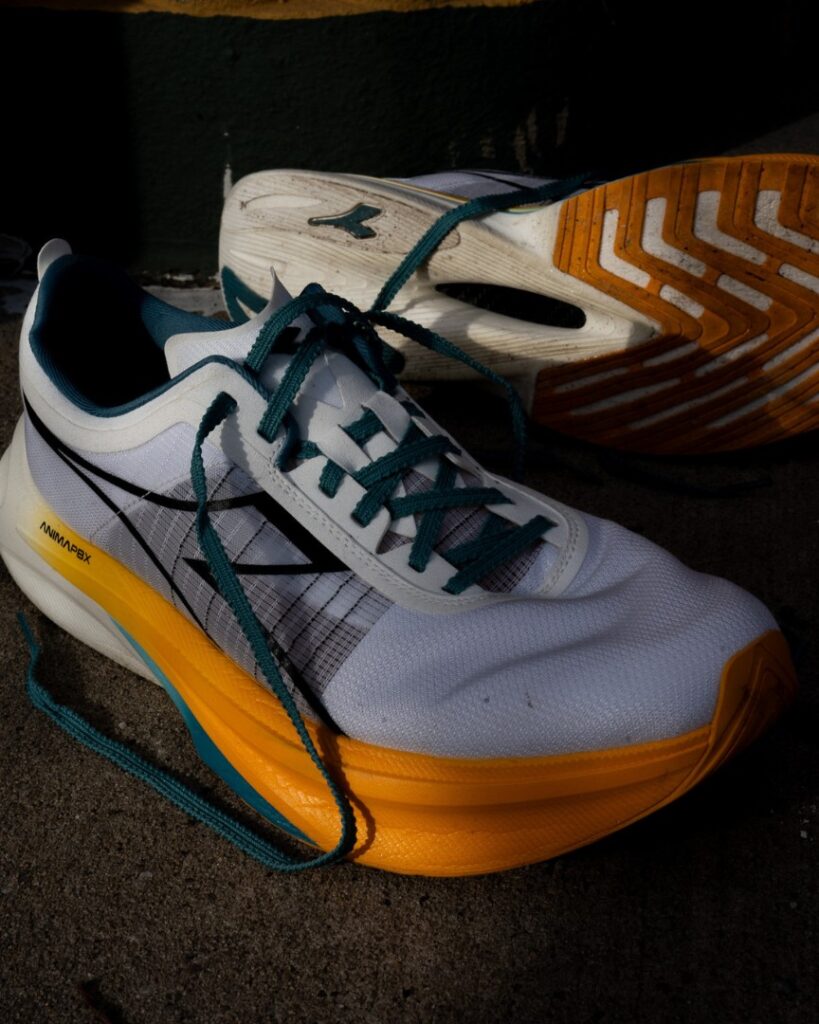
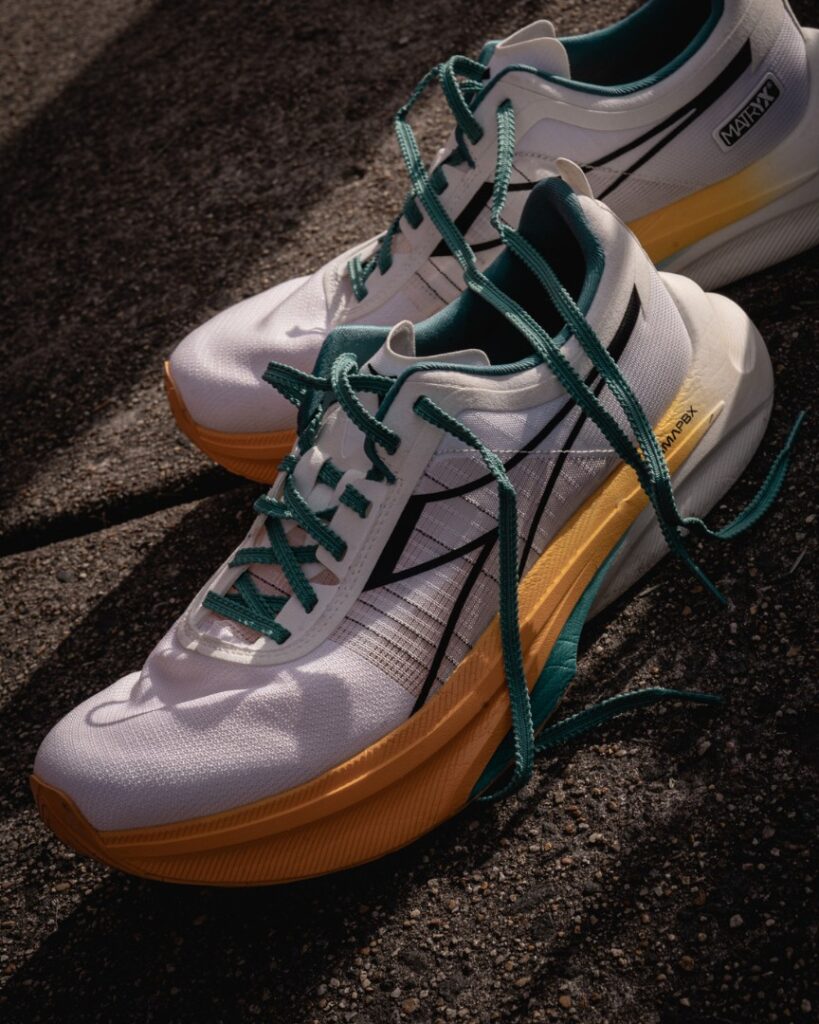
On the run, the Anima PBX midsole acts exactly as you think it would. It’s bouncy, it’s super comfortable, it feels light and fast. It’s a race day shoe, for sure, and easily stacks up with the top-tier options out there. I did a couple hill workouts in the shoe and in both situations I was pretty surprised at my paces. Like, trust me when I say I’m not in that good of shape. The Pebax and carbon plate combo work exactly as they’re supposed to, giving you that pep you want on race day. The shoe handled it all and worked equally as well at slower paces.
For the height of the stack of Pebax in the shoe, it’s also surprisingly stable. Meaning, I felt pretty comfortable running in the shoe, no matter the pace. It’s not an aggressive shoe that keeps you on your toes, like, say, the Asics Metaspeed, Hoka Rocket X 2 or Cielo X1, or Nike Alphafly 3. Instead, it’s more comparable to a much better version of the New Balance SC Elite v3 (the upper alone merits that distinction) or a lighter Saucony Endorphin Pro 4.
However, if you like the balance between comfort, bounce, and performance, then this has to be one of the best options– if not the best– out there.
Trust me when I say that Diadora is putting their name on the map with this shoe.
CARYN: My prior experience with Diadora running shoes is actually pretty limited. Most of the shoes I’ve tried on and seen had a phenomenal aesthetic, but lacked the performance piece needed to make a mark on the industry. When this shoe arrived, I loved the yellow (marigold?), blue and white colorway – classic Diadora with a little spice. I can’t say I usually gravitate toward a shoe with any amount of yellow in the colorway, but Diadora somehow elevated the banana look.
Taking the shoe out of the box, my first thought was that it felt nice and light. A UK size 9 weighs in at 8.1 oz, which puts the Gara Carbon in line with other similar race-day shoes. I took the shoe out for a tempo run, and immediately noticed the pep. The Gara Carbon has a full-length carbon fiber plate and Diadora’s new Anima PBX, which Diadora calls a “special, supercritical foam” (read: their formulation of Pebax) that claims to increase midsole responsiveness by 55% while reducing its weight by 40%
The combination provides a delightfully bouncy, fun ride that makes picking up the pace downright easy. After a few runs, I found the Gara Carbon was reminiscent of the original Nike Zoom Vaporfly 4% – that similar soft, trampoline-like feel without a rocker or aggressive toe-off. I didn’t have issues with lockdown on the run, but do think the Gara Carbon probably lands mid-pack when it comes to overall stability just due to the lack of structure to the upper and sidewalls.
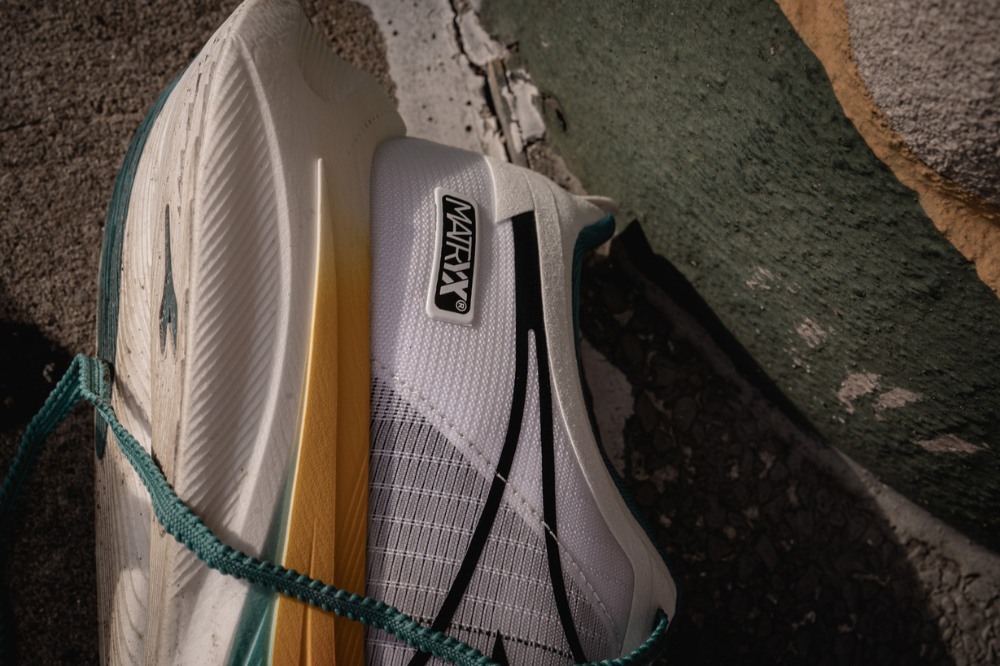
SAM: I’ll get straight to it – absolutely love this shoe. Full stop. The Diadora Gara Carbon is exactly what comes to mind when I think of what I want in a long distance racing shoe. There’s a few reasons why.
First of all, the midsole in this shoe rocks. You have a big slab of Anima PBX, which is their new supercritical Pebax-style compound. I’m not sure about how much stack height is in the shoe but it’s somewhere in the mid-to-high 30 mm range. On top of it is their carbon fiber plate which has no bells and whistles and is there to compliment their midsole, and it does so perfectly. The midsole is responsive, soft, and bouncy.
Occasionally I find newer racing shoes can get slightly too soft with their midsole and can lose responsiveness over the course of a run or race, but I never felt that issue with the Gara. I used it for workouts ranging from 1-mile repeats to long run efforts and found it absolutely dialed in for everything. It is the type of shoe that disappears as you are running in it and lets you focus on running faster and farther, and that is exactly what I look for in a racer.
Something that also impressed me with this shoe is how smooth it is through the stride. I was surprised when writing this review to find out that this shoe has a 5 mm drop. I have flatter arches and if you have read my stability reviews you would know that I am not always a fan of lower drop shoes. But in this case I loved it.
The Gara is built with a design that pushes your foot forward as you are running. The heel of the midsole extends beyond the heel of the upper; combine that with the carbon plate and the wide forefoot and you get a shoe that has a quick and smooth transition for keeping your stride going during fast runs. Everything about this shoe is fun, fast, and efficient. It is designed to get you moving and get out of the way, and all of the features marry together to do that.
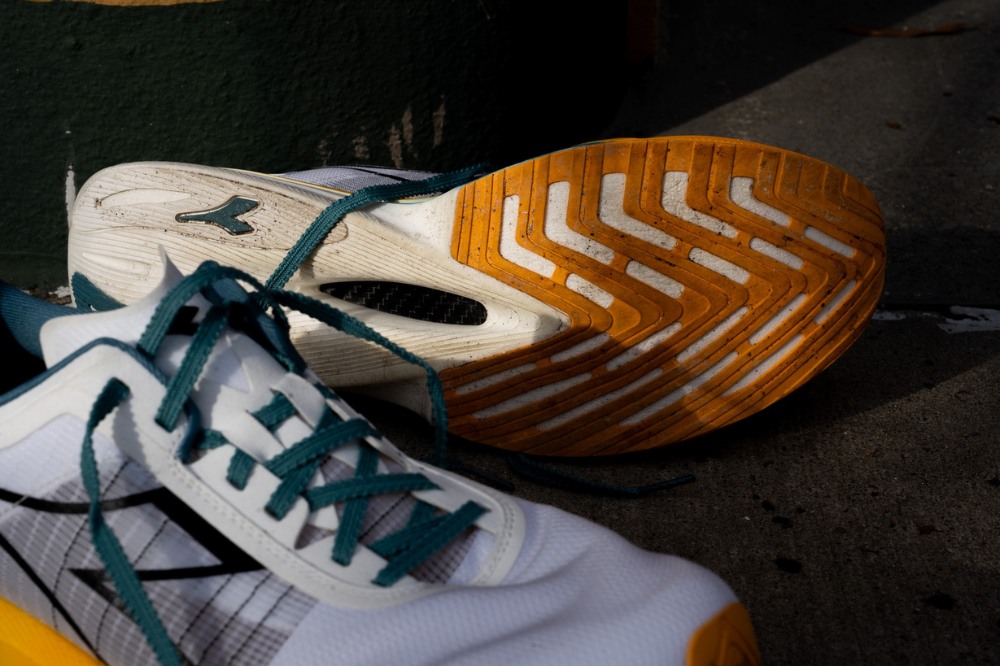
WHAT WE DON’T LIKE ABOUT THE DIADORA GARA CARBON
ROBBE: There is just a tiny bit of what seems to be extra fabric in the toe box. I only noticed it when I first laced them up, and on the run it truly didn’t matter. In fact, I kind of liked a bit of extra room, considering the rest of the lockdown was right on point. With other race day shoes that have questionable heel lock down (Vaporfly or Adios Pro), you for sure need to be locked in throughout the midfoot and toe box. On this shoe, I think there’s a little leeway and I had no issues. But I just wanted to make note of it.
I do think the Pebax is on the softer side in this shoe. That’s not a bad thing, it’s more of a preferential thing. It’s not so soft that you just sink into it and don’t come out alive, but if you love to feel the plate and the aggressiveness of other race day shoes with rockers (Hoka Rocket X 2, Asics Metaspeed Edge+, Salomon S/Lab Phantasm 2), then you may want to look elsewhere.
Yes, the price is $300, which makes this the most expensive race day shoe currently available. And no, it’s not even made in Italy. Again, keep in mind that Diadora did hand-select the most premium ingredients in shoe manufacturing and put them all into its dream shoe. There’s some justification there.
CARYN: This shoe really surprised me, so the bad is far more limited than I expected. That being said, I tend to gravitate toward racing shoes with more of a rocker or more aggressive toe off. This shoe has neither, but seeing as this is a personal preference, it’s not really negative – just something to note.
I liked the overall volume in the toe box, but because the upper lacks structure, it does wrinkle a bit. I’m all for lightweight, but I think Diadora sacrificed the integrity of the upper a bit to trim the shoe down. But truly, the most obvious flag on the field is the price. At $300, it seems steep for a company that’s really just entering this part of the shoe market. I know that Diadora tends to put a premium on their style, but this seems a bit egregious.

SAM: The only real con for me is the lacing on this shoe. Like I said earlier, everything about this shoe feels designed to push you forward, and the laces are no exception. There is no double eyelet and the last eyelet felt somewhat far away from my ankle. The first workout I did in them I could feel the shoe slipping when I was turning, and ended up unlacing the shoe to use the last two eyelets for the classic runners loop. This gave me better heel lock and on my second workout in these shoes I had no slippage problems.
The other less substantial con is that this shoe is $300. Three. Hundred. Dollars. We’re starting to get a bit ridiculous with these prices. This is a great shoe, for sure, but it doesn’t blow me away to the point where I could justify spending $300 on it. That just does not make dollars and sense.

FINAL THOUGHTS ON THE DIADORA GARA CARBON
ROBBE: Trust me when I say I’m as shocked as you that Diadora just dropped what may be one of the best race day shoes of 2024. Not to say I didn’t love some of their shoes before on a personal level; I just never put them in the top tier of performance when it came to race day. I don’t think anybody would have. That’s changed with the Gara Carbon.
The combination of the Matryx upper, Anima PBX midsole, carbon fiber plate, and overall light weight of the shoe make this a race day contender with performance bonafides that match its elegant design. They went all-in on premium performance and ended up with a shoe that deserves to be talked about, both for its Italian-inspired heritage and its forward-focused approach to going fast.
CARYN: Diadora coming in hot with a heavy hitter! I never anticipated liking this shoe so much, but had hope that this time, the performance might line up with the aesthetics a bit more. Thanks to a springy, lightweight ride and great fit, this shoe can certainly hold its own against most, if not all, of the currently available plated options for race day. This guy will certainly have a happy home in my workout day shoe rotation for as long as possible.
SAM: Like Naruto’s Gara in the Fourth Great Shinobi War, the Diadora Gara Carbon is here and ready to make its mark as a fast and comfortable race day option. While I personally cannot justify the price tag, this is a top of the line racing shoe which will melt away the miles after you figure out how to get it laced up. It’s positive to see that the racing shoe arms race is pushing every company to nominate their champion. Hopefully we will get to the point where prices will decrease because of the sheer amount of options available. But if you’re up for dropping the cash, the Gara Carbon will not disappoint.
You can pick up the Diadora Gara Carbon for $300

